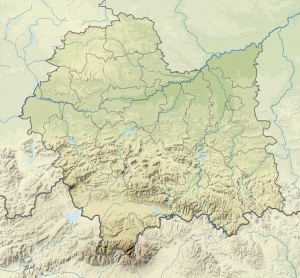Palace of the Government Commission on Income and Finance
| Palace of the Government Commission on Income and Finance | ||
|---|---|---|
|
Front facade |
||
| Creation time : | around 1650 | |
| Castle type : | palace | |
| Conservation status: | Reconstructed | |
| Place: | Warsaw | |
| Geographical location | 52 ° 14 '34.8 " N , 21 ° 0' 2.2" E | |
|
|
||
The Palace of the Government Commission for Income and Finance (Polish: Pałac Komisji Rządowej Przychodów i Skarbu w Warszawie ), also known as the Leszczyński Palace , is located at 5 Plac Bankowy in Warsaw . Today the seat of the Lord Mayor of Warsaw is housed here.
history
Originally the residence of Jan Leszczyński, probably built by Giovanni Battista Gisleni in the middle of the 17th century, stood here . In the second half of the 18th century, the palace was owned by a Józef Potocki, later owned by the Zieliński family . The palace was fundamentally rebuilt between 1823 and 1825 by Antonio Corazzi in the classical style as the seat of the Income and Finance Commission of the Kingdom of Poland . Juliusz Słowacki worked here as a civil servant from 1829 to 1831 . From 1919 to 1921 it was redeveloped under Marian Lalewicz . In 1939 the palace burned down after being hit by bombs at the beginning of the war . It was completely destroyed during the Warsaw Uprising . After the war, under Piotr Biegański in its classical form as the seat of the Presidium of the Council of the City of Warsaw rebuilt, he now serves - together with the adjacent Palace of the Treasury Minister as the seat of to the war in the former Jabłonowski Palace housed the Warsaw President (Mayor, Polish : Prezydent m.st. Warszawy ), the Warsaw municipality (Polish: Urząd Miasta Stołecznego Warszawy ) and the voevoda the Mazovia Province (Polish: Mazowiecki Urząd Wojewódzki ).
architecture
The three-storey palace stands on a horseshoe-shaped floor plan with a central building located far below the main courtyard . This central part is dominated by a six-column Corinthian portico . The sculptures in the tympanum of this portico are by Paweł Maliński and depict allegories of wisdom ( Minerva ), industry ( Jason ), trade ( Mercury ), the Vistula and the Bugs . The frieze with putti and garlands above the second floor comes from probably from a M. Vincenti.
The side wings of the complex are designed up to halfway through the middle of the courtyard in the style of the central building. In the further course to Plac Bankowy they only have two floors; both wings are then also narrower than the main wing. In the center of the courtyard they are each provided with a four-column Ionic portico. Towards Plac Bankowy they have monumental (also Ionic) colonnades. Here - towards the square - the wings are each crowned by a stepped gable with a free-standing cartridge .
In the main vestibule on the upper floor there is a bust of Juliusz Słowacki.
References and comments
- ^ Jan Leszczyński (1603-1678) was a Polish voivod and from 1666 Grand Crown Chancellor
- ↑ it is the Ministry of Finance
- ^ Paweł Maliński (1790-1853) was a Polish sculptor and freemason
See also
Web links
- Information with a historical illustration at Warszawa1939.pl (in Polish)
literature
- Julius A. Chroscicki and Andrzej Rottermund, Architectural Atlas of Warsaw , 1st edition, Arkady, Warsaw 1978, p. 62
- Discover Małgorzata Danecka, Thorsten Hoppe, Warsaw. Tours through the Polish capital , Trescher Verlag, ISBN 978-3-89794-116-8 , Berlin 2008, p. 128
- Tadeusz S. Jaroszewski, Palaces and Residences in Warsaw, Interpress Publishing House, ISBN 83-223-2049-3 , Warsaw 1985, p. 57 ff.
- Janina Rukowska, Travel Guide Warsaw and Surroundings , 3rd edition, ISBN 83-217-2380-2 , Sport i Turystyka, Warsaw 1982, p. 59 f.


